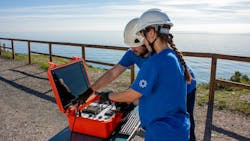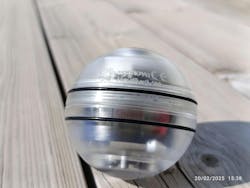AI-driven leak detection: Deploying smart technology in Dublin's critical water infrastructure
Irish water utility Uisce Éireann needed help detecting leaks and required condition assessments of the trunk mains network in the Greater Dublin area. As Aganova's chief operating officer, I'll share the technical challenges we've encountered deploying smart technology in aging infrastructure and the early insights from our work on this project.
Greater Dublin’s water network comprises approximately 10,000km (6,213 miles) of water mains, of which 2,500km (1,553 miles) are trunk mains. According to Uisce Éireann, Dublin relies heavily on 19th-century infrastructure to deliver its drinking water.
The majority of the area’s water is sourced from the River Liffey, which runs for 132km (82 miles) and supplies more than two million residents and most of the region’s industry. Five times more water is taken from the Liffey than from any other river in Ireland.
However, the aging network loses more than 30% of all treated water to leaking pipes before it reaches Uisce Éireann’s customers’ taps. This happens every single day. Not only does this waste money, but it also wastes natural resources and puts significant pressure on the region’s water provisions.
As with many regional water networks, the difficulty of discovering exactly what was happening, where, and when it started has always proved both challenging and expensive to rectify.
Uisce Éireann decided it needed to understand its network in greater detail, to understand where leaks were happening, or likely to happen, and to improve its approach to maintenance. The benefits of this approach would be to reduce the amount of water lost to leaks and reduce the stress placed on the River Liffey.
With such a huge network, a decision was made to focus on the trunk areas with the highest levels of leakage. At the same time, Microsoft was exploring projects to increase water resilience of the Liffey basin that feeds some of their regional data centers, as part of their goal to produce more water than they consume by 2030. As an existing Microsoft water replenishment supplier, our team collaborated with local partner Suez to work together on an innovative water-saving project with Uisce Éireann, focusing on leak detection and repair of their most challenging trunk mains.
What were the overall project goals?
The project had two main aims:
- Reduce water lost to leakage by finding and locating leaks quickly before water loss becomes too great and too expensive to repair; and by identifying potential issues to allow preventive maintenance.
- Reduce the amount of water taken from the Liffey, which currently stands at 600 million liters of water a year (158 MGY), in what amounts to a replenishment of the Greater Dublin area watershed.
The challenge presented by trunk mains
Not all water pipes are equal, as I've learned from working with water utilities over many years. Trunk mains are often located in rural areas, under quite permeable soil, making their leaks invisible to the eye and almost impossible to locate without in-line inspection equipment and knowledge.
As an added complication, they are often dug deeper into the ground than the smaller distribution network pipes, so leaks can remain unnoticed for longer periods, resulting in higher volumes of lost water.
In my experience, this detection difficulty can significantly affect how utilities perceive their network condition. For instance, one of our customers, one of the biggest water utilities in Europe, was managing a very old pipe which conveyed water throughout a region. They believed that the whole system was in very bad shape because it was losing almost 1 million m3 of water yearly, in a section that covered less than 60km.
We inspected the pipe and found that the pipe was really in very good shape except for three specific points, one of them showing a leak of 25 l/s, almost 78% of the water lost in the whole 60km pipe.
To me, this example reveals three truths when it comes to leak detection and assessing the condition of water networks:
- We do not know the actual condition of the pipe until we inspect it from the inside.
- The volume saved by repairing a leak in a trunk main could be higher than the water saved by tackling dozens of reported leaks in smaller pipes.
- Knowing the actual issues of the pipes can save millions in pipe restoration or replacement programs.
The solution
I believe our approach at the company is unique. In water distribution, there are two assets, one is water, the other is the pipe. We take care of them both; we detect leaks, and we assess the condition of the pipes as well.
To detect leaks in the Greater Dublin area's trunk mains network, we deployed our Nautilus technology — a free-swimming acoustic inspection system designed specifically for large-diameter pressurised pipelines.
The platform integrates multiple acoustic sensors in a neutrally buoyant spherical housing, enabling it to traverse up to 35km of pipeline per deployment while maintaining consistent sensor positioning. The acoustic array continuously monitors the pipe wall through 360-degree scanning, capturing leak signatures and structural anomalies as the device moves through the network.
It utilizes AI-driven analysis that provides real-time detection of leaks and anomalies such as air or gas pockets, accurate to under one meter. The sensors also provide flow rate to determine the severity of a leak or anomaly, and pressure and magnetic profiling to highlight early warning signs of corrosion and cracks.
One of the major benefits of the this technology is that it offers non-invasive, in-line inspections that operate while the pipeline remains in service, providing accurate detection without the need to interrupt services. Its natural buoyancy systems allow it to move along a trunk main without bumping into obstacles, which increases the accuracy of its readings.
The sphere was developed through years of field inspection experience, incorporating lessons learned and adjustments along the way. Few changes are needed to the system, regardless of the project or its requirements. None were required for the Dublin project.
Safety is paramount in drinking water systems, and the device has received a number of key certifications that attest it is safe for use in potable water operations, for example, in the USA, Canada, and the UK.
The technical challenges of deploying in Greater Dublin
Dublin’s ageing infrastructure presented several challenges ahead of the deployment of the system. Drawing from our experience across more than 4,000km of previous pipeline assessments, we knew that successful deployment hinges on addressing two fundamental requirements: establishing suitable insertion and extraction points for the sensor platform, and understanding navigation conditions throughout each pipeline section.
The system operates in any pressurized water piping system with a minimum diameter of 250mm and flow velocities above 0.1 m/s, making it well-suited for Dublin's trunk main network specifications.
What preparation was needed before the project began?
For Dublin, all known technical issues were identified beforehand.
Each project begins with exchanging drawings and consulting the customer's engineers; gathering detailed information on pipe alignment, connections, fittings, and conditions is essential. A pre-inspection field survey is also necessary to assess these elements and ensure health and safety compliance and a smooth inspection performance.
Our study showed insufficient insertion and extraction points (typically DN100 air valves), so hot-tapping is being used to install them as needed. At no stage is the water supply interrupted.
What role does AI play in the system?
AI plays a strategic role in the system. It is used to improve decision-making, efficiency, and resource management.
By integrating AI, we can detect leaks accurately, reduce costs, and minimize downtime and excavation. Our investment in advanced AI enables proactive failure prediction and reconstruction of undocumented pipe layouts, supporting better planning.
Key Nautilus AI features include:
- Leak detection using deep learning and automated analysis
- Integrated data for improved pinpointing accuracy
- Leak flow rate estimation from multiple data sources
- CO2 emissions savings potential at every detected leak
- Pipe condition assessment
Overall, AI integration enables utilities to make faster, more informed maintenance decisions while reducing operational costs and minimising service disruptions to customers.
Working in partnership with Microsoft and Suez
This project brings together complementary expertise from Microsoft and Suez alongside our acoustic and electromagnetic sensing capabilities.
Collaboration is vital for progress. In discussions with stakeholders in municipal water and industrial stewardship, we found Uisce Éireann and Microsoft's water-saving goals were closely aligned. By structuring the project with Suez as the regional technical partner, we maximized synergy among all parties.
In terms of what each partner contributed to the overall project: Uisce Éireann focuses on improving trunk mains efficiency and provides engineering and monitoring; Microsoft aims for a positive water impact by 2030, offering funding and technology; we deliver innovative solutions; and Suez delivers field service for the Aganova Nautilus system. Together, these partners are advancing trunk mains management.
About the Author
Marcos Barrera
Marcos Barrera is chief operating officer at Aganova. He brings extensive experience in international water engineering and business development, including over five years in the United States where he participated in negotiations for an $850 million water supply contract with the city of San Antonio, Texas. He is a graduate of UT McCombs School of Business and San Telmo Business School.

